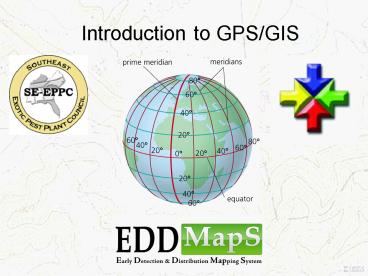Introduction to GPSGIS - PowerPoint PPT Presentation
Title:
Introduction to GPSGIS
Description:
Using a hand-held GPS unit. Online method (more on this later) GPS Equipment. Handheld ... Most USGS topographic maps used the survey points from 1927 (NAD27) ... – PowerPoint PPT presentation
Number of Views:57
Avg rating:3.0/5.0
Title: Introduction to GPSGIS
1
Introduction to GPS/GIS
2
Collecting location data
- Coordinates that denote the location of an
infestation - Using a hand-held GPS unit
- Online method (more on this later)
3
GPS Equipment
Palm
Handheld
Survey
4
Coordinate Systems
- Coordinate settings
- UTM x,y, and zone
- Lat/Long x and y
- Datum
- (NAD27 and NAD83)
5
UTM Coordinates
- Universal Transverse Mercator
- Originally used by US Army on large scale maps
- Grid system
- Divides the earth into 60 zones (each 6 degrees
of longitude wide) - X,Y system in meters east of zone line and north
of equator (in Northern Hemisphere)
6
(No Transcript)
7
UTM Coordinates
- Location data in a combination of X,Y and zone
- Southeast lies within Zone 16, Zone 17 and Zone 18
8
Lat/Long Coordinates
- Based on degrees of a circle (360º total)
- Latitude expressed as degrees north of equator
(Southern Hemisphere is denoted by a negative) - Longitude expressed as degrees east of the Prime
Meridian (west is denoted by a negative with the
maximum value of 180º and minimum value of -180º)
Lines of Latitude
Lines of Longitude meridians
9
-
10
Latitude-Longitude
- Latitude
- Starts at Equator
- 90ºN and 90ºS
- U.S. 24º and 49º
- Longitude
- Starts at Prime Meridian
- 180ºE and 180ºW (denoted with a negative)
- U.S. -65º and -125º
11
Latitude-Longitude
- All values for longitude in the United States
will be a negative number
12
33.75333, -86.59917
13
33.75333, 86.59917
14
Latitude-Longitude data
- DD/MM/SS (Degrees,minutes,seconds)
- DD/MM.MMM (Degrees, decimal minutes)
- DD.DDDDD (Decimal degrees)
- Same coordinate system, different ways of
expressing it
15
Latitude-Longitude data
- 32º 45 12 x -84º 35 57 DD/MM/SS
- 32º 45.2000 x -84º 95.00 DD/MM.MMM
- 32.75333º x -84.59917º DD.DDDDD
16
(No Transcript)
17
Datum
- Set of surveyed points used as a reference for
making maps - Most USGS topographic maps used the survey points
from 1927 (NAD27) - Those points were re-surveyed and corrected in
1983 (NAD83) - WGS84 is another datum often used, essentially
the same as NAD83
18
Collecting location of an infestation
- We prefer that you use Latitude/Longitude
expressed in Decimal degrees - With NAD83 (or WGS84) datum
- Most GPS units have the ability to set coordinate
system
19
Using a handheld GPS
- Single point to denote entire infestation
- Try to collect that point in the center of the
infestation
20
Using a handheld GPS
21
Recording point data
- Stand at, or as near as you can to, the center of
the infestation - Make sure the GPS is set to show lat/long data in
decimal degrees (DD.DDD) - Make sure datum is set to 1983 (NAD83)
- Often, the longer the GPS is stationary, the more
accurate the point is
22
(No Transcript)
23
Recording point data
- Either write-down the coordinates (record at
least 5 decimal places) or create a waypoint (so
that you can write it down later) - Title the point something that can associate it
with the area or invasive species (Dougs farm
or Garlic Mustard 1)
24
(No Transcript)
25
(No Transcript)
26
(No Transcript)































